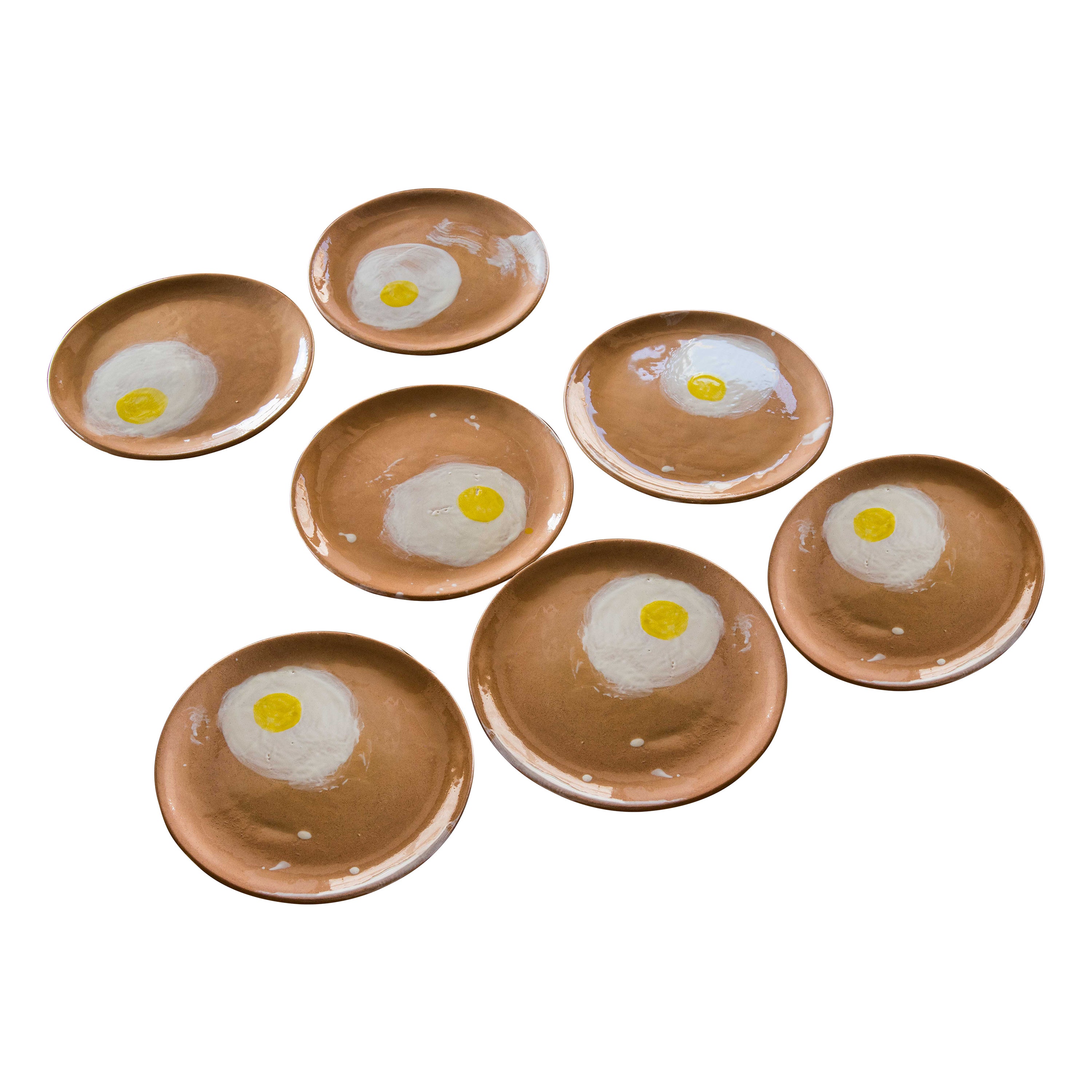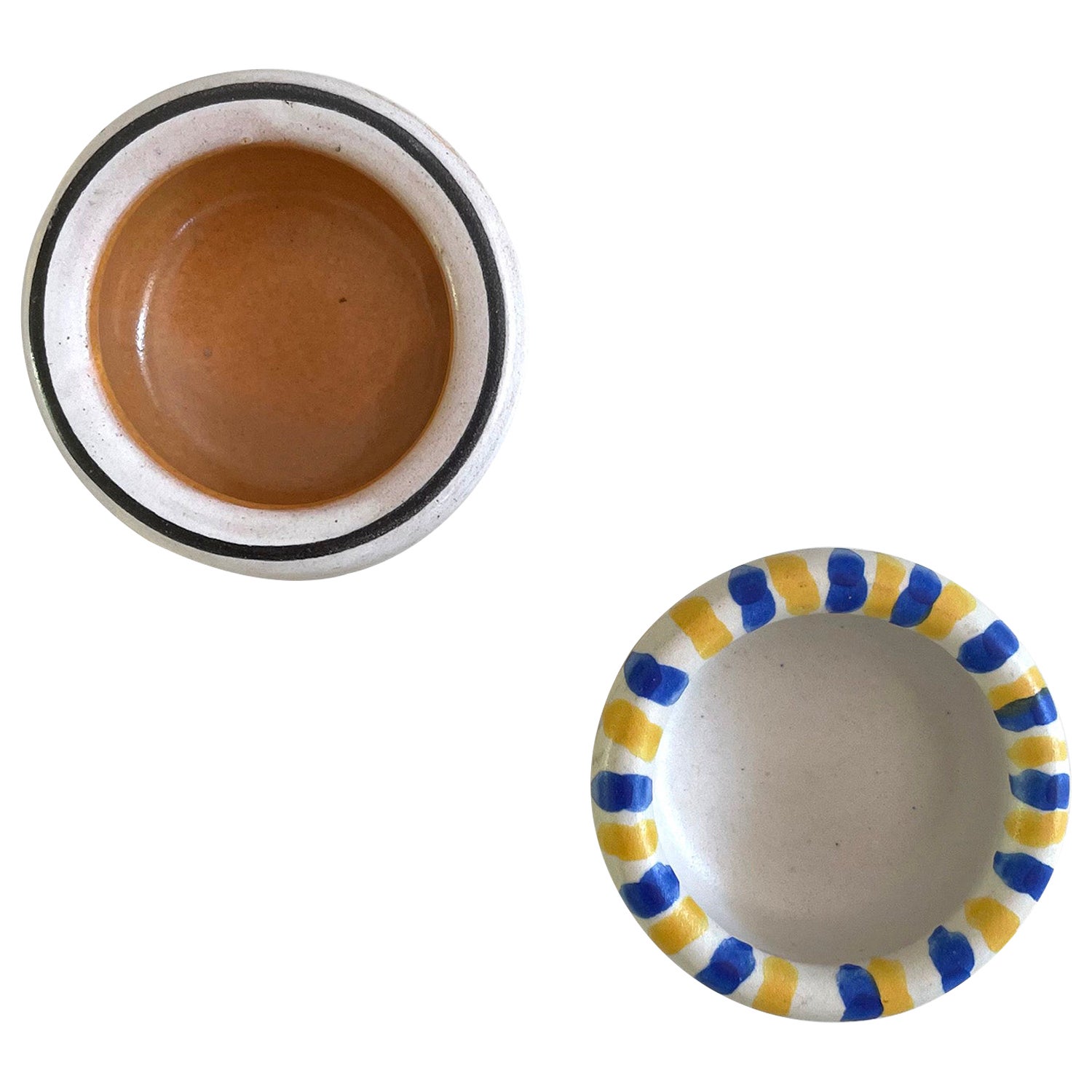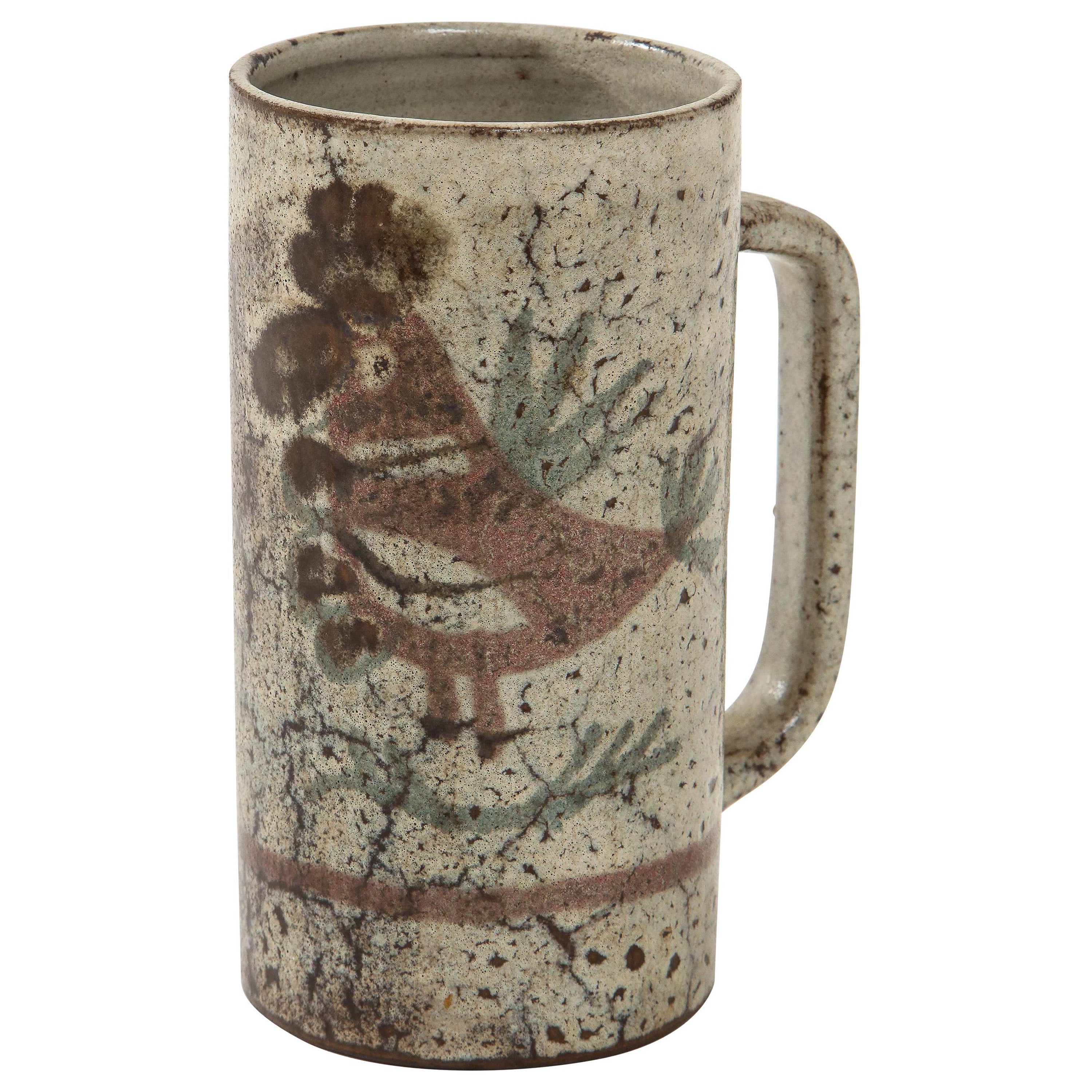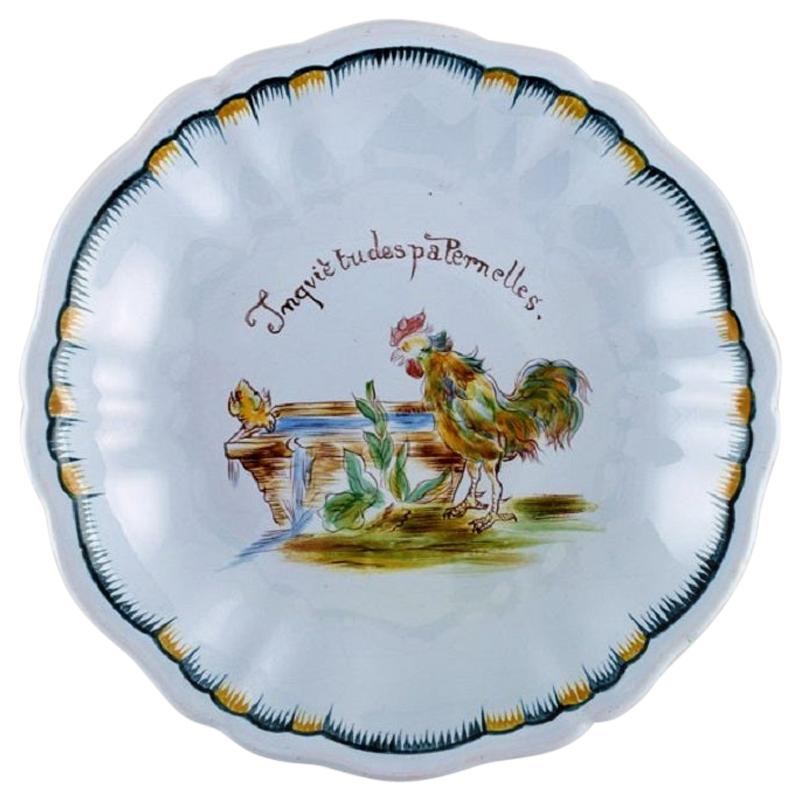Items Similar to 3 Hand-painted Islamic Platters / Bowls
Want more images or videos?
Request additional images or videos from the seller
1 of 11
3 Hand-painted Islamic Platters / Bowls
About the Item
3 North African Pieces of Decorative Tableware / Bowls / Platters. Each made using the 19th century method of vegetable dyes and designed with simple, repetive elements
Sold Individually.
- Dimensions:Height: 3.5 in (8.89 cm)Diameter: 14 in (35.56 cm)
- Style:Islamic (Of the Period)
- Place of Origin:
- Period:
- Date of Manufacture:19th Century
- Condition:Minor losses. . There are small losses or chips consistent with age and use.
- Seller Location:New York, NY
- Reference Number:
About the Seller
5.0
Gold Seller
These expertly vetted sellers are highly rated and consistently exceed customer expectations.
Established in 1997
1stDibs seller since 2004
209 sales on 1stDibs
Typical response time: 1 hour
Associations
20th Century Specialists
- ShippingRetrieving quote...Ships From: New York, NY
- Return PolicyA return for this item may be initiated within 7 days of delivery.
More From This SellerView All
- Large French Midcentury Rectangular Red Ceramic Serving Platter Voltz, VallaurisBy Vallauris AMLocated in New York, NYVery large French Mid-Century Modern rectangular, red ceramic serving platter or tray handmade by Voltz, Vallauris. Signed on reverse, Voltz, Vallauris, France. A large oval red c...Category
Mid-20th Century French Mid-Century Modern Ceramics
MaterialsCeramic, Clay
- Large French Midcentury Oval Red Ceramic Serving Platter by Voltz, VallaurisBy Vallauris AMLocated in New York, NYVery large French Mid-Century Modern oval red ceramic serving tray or platter, handmade by Voltz, Vallauris, France circa 1950-1960. Signed on the...Category
Mid-20th Century French Mid-Century Modern Ceramics
MaterialsCeramic, Clay
- Five Islamic Wrought Iron Wall Decorations or SculpturesLocated in New York, NYOriginal hand-wrought Islamic ironwork from French North Africa serving as wall-mounted sculptures / decorative art panels. Sober, beautiful, timeless. 5 pieces. Priced and sold ...Category
Antique 19th Century Maghreb Islamic Decorative Art
- Four Franco-Islamic Carved Wood and Leather Lounge ChairsLocated in New York, NYTwo pairs of dramatic club or lounge chairs with arm and backrests in the form of carved columns supporting Islamic arches. The pieces are complete with a...Category
Vintage 1930s French Islamic Club Chairs
MaterialsWood, Leather
- Ceramic Plate Visage Gris 'Grey Face' A.R. 206 by Pablo Picasso & Madoura, 1953By Pablo Picasso, MadouraLocated in New York, NYThe engraved and brush painted ceramic plate, Visage Gris (Grey Face) is one the most iconic pieces created by Pablo Picasso (1881 - 1973) at the Madoura workshop in Vallauris, France. It is said "all portraits are self portraits". In this work, we see Picasso's wistfulness, vulnerability and humor set within a beautiful image representing both the sun and the moon, the masculine and the feminine. Picasso mastery of form, image, composition and subtle color is evident in a work that resonates transcendence. Created in 1953, Pablo Picasso ceramic Visage Gris (Grey Face), 1953 A.R. 206 is a Madoura white earthenware clay, knife engraved under partial brushed glaze with decoration in engobes (green, black, white) from the edition of 500. This work is stamped with the 'Madoura PLEIN FEU' and ‘EMPREINTE ORIGINALE DE PICASSO’ pottery stamps on the reverse. Dimensions: 12 3/8 x 15 1/8 x 1 5/8in (31.4 x 38.3 x 4.1cm). Madoura was an artisan workshop created by Georges and Suzanne Ramie which collaborated with Picasso in the fabrication and hand painting of the works. Pablo Picasso designed 633 different ceramic editions between 1947 and 1971 at the Madoura workshop, with a number of variants and unique pieces resulting from these initial works. He began by creating simple, utilitarian objects such as plates and bowls, but later produced more complex forms, including pitchers and vases — their handles occasionally shaped to form facial features, or anatomical parts of his animal subjects. Picasso remains one of the highest-grossing artists at auction today, and the range of his ceramics means it's possible to find both a good investment and a beautiful object. Visage Gris is among the most important. A Short Biography follows: Pablo Picasso revolutionized the art world and to many is THE artist of the 20th century. He is famous for his role in pioneering Cubism with Georges Braque and for his melancholy Blue Period pieces. Original signed Picasso lithographs and prints are a sure investment. Madoura Picasso ceramics are highly collectible in their own right. As one of the most influential Modern artists of the 20th century, Pablo Picasso is renowned as a legendary artistic master to this day. Born on October 25, 1881 in Malaga, Spain, Pablo Picasso was a child prodigy who was recognized as such by his art-teacher father, who ably led him along. The small Museo de Picasso in Barcelona is devoted primarily to his early works, which include strikingly realistic renderings of casts of ancient sculpture. Picasso was a rebel from the start and, as a teenager, began to frequent the Barcelona cafes where intellectuals gathered. He soon went to Paris, the capital of art, and soaked up the works of Edouard Manet, Gustave Courbet, and Henri de Toulouse-Lautrec, whose sketchy style impressed him greatly. Then it was back to Spain, a return to France, and again back to Spain – all in the years 1899 to 1904. Before he struck upon Cubism, Picasso went through a prodigious number of styles – realism, caricature, the Blue Period, and the Rose Period. These distinguished styles are apparent in the unique original works as well as Picasso ceramics, lithographs, linocuts, and etchings that he created later in his life. The Blue Period dates from 1901 to 1904 and is characterized by a predominantly blue palette and focuses on outcasts, beggars, and prostitutes. This was when he also produced his first sculptures. The most poignant work of the style, La Vie (1903), currently located in Cleveland’s Museum of Art, was created in memory of his childhood friend, the Spanish poet Carlos Casagemas, who had committed suicide. The painting started as a self-portrait, but Picasso’s features became those of his lost friend. The composition is stilted, the space compressed, the gestures stiff, and the tones predominantly blue. The Rose Period began around 1904 when Picasso’s palette brightened and is dominated by pinks and beiges, light blues, and roses. His subjects are saltimbanques (circus people), harlequins, and clowns, all of whom seem to be mute and strangely inactive. One of the premier works of this period is Family of Saltimbanques (1905), currently in Washington, D.C. at the National Gallery, which portrays a group of circus workers who appear alienated and incapable of communicating with each other, set in a one-dimensional space. In 1905, Picasso went briefly to Holland, and on his return to Paris, his works took on a classical aura with large male and female figures seen frontally or in distinct profile, as in early Greek art. One of the best examples of this style is in the Albright-Knox Gallery in Buffalo, NY, La Toilette (1906). Several pieces in this new, classical style were purchased by Gertrude Stein (the art patron and writer) and her brother, Leo Stein. With his groundbreaking 1907 painting Les Demoiselles d’Avignon...Category
Mid-20th Century French Mid-Century Modern Figurative Sculptures
MaterialsEarthenware
- French Mid-Century Modern / Art Deco Ceramic Amphora/ Vase /Pitcher, 1930 SignedLocated in New York, NYElegant French Mid-Century Modernist / Art Deco ceramic amphora / pitcher / vase. Signed on bottom.Category
Mid-20th Century French Mid-Century Modern Ceramics
MaterialsCeramic
You May Also Like
- Hand-made Contemporary 8 Large Ceramic Egg Plates Majolica Serve-ware PlatterBy Lorenzo LorenzzoLocated in Queretaro, QueretaroCeramic 8 plate in modern egg design by artist Lorenzo Lorenzzo. Lorenzo's work alludes to his favourite meal, breakfast, creating a contemporary design for this plate collection.Category
2010s Mexican Modern Tableware
MaterialsMajolica
- French Ceramic Pinch Bowls by Robert PicaultBy Robert PicaultLocated in Los Angeles, CARobert Picault pinch bowls France, circa 1950’s Playful Picault, at it again! Your salt & pepper will never look better Each vessel is hand crafted with unique and playful patter...Category
Vintage 1950s French Tableware
MaterialsCeramic
- Quimper French Ceramic Pottery Salt & Pepper Pinch BowlsLocated in Los Angeles, CAQuimper French ceramic pottery salt & pepper pinch bowls Add a wonder pop of color to any kitchen counter with these handy vessels Organic composition and feel Perfect addition to an...Category
Mid-20th Century French Ceramics
MaterialsPottery
- Decorative Hand-Painted Ceramic Jug by Gustave Raynaud, Vallauris, France, 1960By Gustave ReynaudLocated in New York City, NYDecorative Mid-Century Hand-Painted Ceramic Jug by Gustave Raynaud, Vallauris, France, circa 1960. This delightful jug is cylindrical in shape and h...Category
Mid-20th Century French Mid-Century Modern Ceramics
MaterialsCeramic
- Jens H. Quistgaard for Bing & Grøndahl, 9 Relief Bowls / Bottle TraysLocated in Copenhagen, DKJens H. Quistgaard (1919-2008) for Bing & Grøndahl / Nissen Kronjyden. 9 Relief bowls / bottle trays in glazed stoneware. Beautiful glaze in mustard yel...Category
Vintage 1960s Danish Scandinavian Modern Tableware
MaterialsStoneware
- Emile Gallé for St. Clement, Nancy, Antique Compote in Hand Painted FaienceLocated in Copenhagen, DKEmile Gallé for St. Clement, Nancy. Antique compote in hand painted faience with a motif of a rooster, 1870s-1880s. Measures: 23.5 x 10.5 cm. Signed....Category
Antique 1870s French Arts and Crafts Ceramics
MaterialsFaience
Recently Viewed
View AllMore Ways To Browse
Antique Chinese Porcelain Dish
Georgian Blue Glass
Chinese Export Canton
Export Chinese Bowl
Chinese Antique Book
Bowl China Blue
Chinese Bowl Blue
Canton Porcelain
Sottsass Ceramics
White Pagoda
Blue Chinoiserie Pattern
Circa 1813
Chinese Ceramics Pink
Spanish Ceramic Painted
Japan Blue Cobalt
Masons Ironstone
Mason Ironstone
Set Of Majolica





